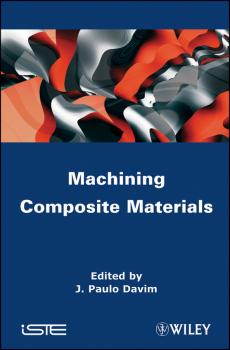ТОП просматриваемых книг сайта:
J. Davim Paulo
Список книг автора J. Davim PauloАннотация
This book provides the fundamentals and recent advances in nano and micromachining for modern manufacturing engineering. It begins by outlining nanomachining before discussing various advances in field and machining processes. The coverage concludes with an evaluation of subsurface damages in nano and micromachining and a presentation of applications in industry. As such, this book serves both as a useful classroom text for engineering and machining courses at the undergraduate and graduate level, and as a reference for academics and engineers in these areas.
Аннотация
Machinability of Advanced Materials addresses the level of difficulty involved in machining a material, or multiple materials, with the appropriate tooling and cutting parameters. A variety of factors determine a material’s machinability, including tool life rate, cutting forces and power consumption, surface integrity, limiting rate of metal removal, and chip shape. These topics, among others, and multiple examples comprise this research resource for engineering students, academics, and practitioners.
Аннотация
Recent advances into the wear of advanced materials In general, wear is currently defined as “the progressive loss of material from the operating surface of a body occurring as a result of relative motion at the surface”. It is related to surface interactions and more specifically to the form of contact due to relative motion. Wear is rarely catastrophic but does reduce the operating efficiency of machine components and structures. At this time of economic crisis, this is a very important field of study because of the huge impact the wear of materials has on the economy. The purpose of this book is to present a collection of examples illustrating the state of the art and research developments into the wear of advanced materials in several applications. It can be used as a research book for a final undergraduate engineering course (for example into materials, mechanics, etc.) or as the focus of the effect of wear on advanced materials at a postgraduate level. It can also serve as a useful reference for academics, biomaterials researchers, mechanical and materials engineers, and professionals in related spheres working with tribology and advanced materials.
Аннотация
Wood as an engineering material can be technically defined “as a hygroscopic, orthotropic, biological, and permeable material having extreme chemical diversity and physical complexity with structures, that vary extensively in their shape, size, properties and function”. Therefore, using wood to its best advantage and most efficiency in engineering applications, specific characteristics or chemical, physical and mechanical properties must be considered. The products are divided into two classes, solid wood and composite wood products. Solid wood includes shipbuilding, bridges, flooring, mine timbers, etc. Composite wood products include insulation board, plywood, oriented strand board, hardboard and particle board. In recent years, the machining of wood products has acquired great importance due the short supply of wood and increasing environmental awareness among users and manufacturers. The optimization of the machining process centers around the mechanism of chip formation, tool wear, workpiece surface quality, crack initiation and propagation of different types of wood. Other factors are also humidity, temperature, static preloads, and vibrations that can affect the wood during the machining process. The book provides some fundamentals and recent research advances on machining wood and wood products.
Аннотация
Tribology is the “science and technology of interacting surfaces in relative motion” and encompasses the study of friction, wear and lubrication. By extension biotribology is usually defined as the tribological phenomena occurring in either the human body or in animals. Therefore, it is possible to consider tribological processes that may occur after implantation of an artificial device in the human body and the tribological processes naturally occurring in or on the tissues and organ of animals. Animals, including humans, possess a wide variety of sliding and frictional interfaces. The authors aim to provide some advances in research in biotribology. They cover several aspects of biotribology such as tribology of synovial joints and artificial replacements; wear of screws and plates in bone fractures repair; wear of denture and restorative materials; friction of the skin and comfort of clothing; wear of replacement heart valves; tribology of contact lenses and ocular tribology; biotribology on the microscale and nanoscale levels, etc. This book can be used as a research text for final undergraduate engineering courses (for example, materials, biomedical, etc.) or for those studying the subject of biotribology at the postgraduate level. It can also serve as a useful reference for academics, biomechanical researchers, biologists, chemists, physicists, biomedicals and materials engineers, and other professionals in related engineering, medicine and biomedical industries.
Аннотация
The term Mechatronics is a combination of the words “mechanics” and “electronics”. It is the blending of mechanical, electronic, and computer engineering into an integrated design and implementation. Mechatronics systems employ microprocessors and software as well as special-purpose electronics. The main objective of this interdisciplinary engineering field is the study of automated devices (e.g. robots) from an engineering perspective, thinking about the design of products and manufacturing processes. Today, mechatronics is having a significant and increasing impact on engineering – in the design, development, and operation of engineering systems. Mechatronics systems and products are well established in a great number of industries, such as the aircraft, automotive, computer, electronics, robotics/automation, manufacturing systems, computerized machine tools, communications, and biomedical industries. This book provides details on recent advances in mechatronics, and can be used as a guidebook for final undergraduate engineering courses (for example, mechanical, electronic, computer engineering) or as a reference to the subject of mechatronics at the postgraduate level. It can also serve as a useful reference for academics, mechatronics researchers, mechanical, electronic and computer engineers, and professionals in areas related to mechatronics and robotics.
Аннотация
According to the NACFAM (National Council for Advanced Manufacturing USA) Sustainable Manufacturing is defined as the creation of manufactured products that use processes that are non-polluting, conserve energy and natural resources, and are economically sound and safe for employees, communities, and consumers. The book covers Sustainable Manufacturing techniques such as materials and manufacturing for renewable energies; clean manufacturing technology; ecological manufacturing; energy-efficient manufacturing; remanufacturing; recycling of materials; environmentally conscious design and manufacturing processes; sustainable advanced manufacturing systems; manufacturability in sustainable product design; education and training for sustainable manufacturing.
Аннотация
In recent years, the application of composite materials has increased in various areas of science and technology due to their special properties, namely for use in the aircraft, automotive, defence, aerospace and other advanced industries. Machining composite materials is quite a complex task owing to its heterogenity, and to the fact that reinforcements are extremely abrasive. In modern engineering, high demands are placed on components made of composites in relation to their dimensional precision as well as their surface quality. Due to these potential applications, there is a great need to understand the questions associated with machining composite materials. This book aims to provide the fundamentals and the recent advances in the machining of composite materials (polymers, metals and ceramics) for modern manufacturing engineering. The three parts of the book cover the machining of polymeric, metal and ceramic matrix composites. This book can be used as a text book for the final year of an undergraduate engineering course or for those studying machining/composites at the postgraduate level. It can also serve as a useful work of reference for academics, manufacturing and materials researchers, manufacturing and mechanical engineers, and professionals in composite technology and related industries.
Аннотация
Mechanical Engineering is defined nowadays as a discipline “which involves the application of principles of physics, design, manufacturing and maintenance of mechanical systems”. Recently, mechanical engineering has also focused on some cutting-edge subjects such as nanomechanics and nanotechnology, mechatronics and robotics, computational mechanics, biomechanics, alternative energies, as well as aspects related to sustainable mechanical engineering. This book covers mechanical engineering higher education with a particular emphasis on quality assurance and the improvement of academic institutions, mechatronics education and the transfer of knowledge between university and industry.
Аннотация
Generally a laser (light amplification by stimulated emission of radiation) is defined as “a device which uses a quantum mechanical effect, stimulated emission, to generate a coherent beam of light from a lasing medium of controlled purity, size, and shape”. Laser material processing represents a great number of methods, which are rapidly growing in current and different industrial applications as new alternatives to traditional manufacturing processes. Nowadays, the use of lasers in manufacturing is an emerging area with a wide variety of applications, for example, in electronics, molds and dies, and biomedical applications. The purpose of this book is to present a collection of examples illustrating the state of the art and research developments to lasers in manufacturing, covering laser rapid manufacturing, lasers in metal forming applications, laser forming of metal foams, mathematical modeling of laser drilling, thermal stress analysis, modeling and simulation of laser welding, and the use of lasers in surface engineering. This book can be used as a research book for a final undergraduate engineering course or as a subject on lasers in manufacturing at the postgraduate level. Also, this book can serve as a useful reference for academics, laser researchers, mechanical, manufacturing, materials or physics engineers, or professionals in any related modern manufacturing technology. Contents 1. Laser Rapid Manufacturing: Technology, Applications, Modeling and Future Prospects, Christ P. Paul, Pankaj Bhargava, Atul Kumar, Ayukt K. Pathak and Lalit M. Kukreja. 2. Lasers in Metal Forming Applications, Stephen A. Akinlabi, Mukul Shukla, Esther T. Akinlabi and Tshilidzi Marwala. 3. Laser Forming of Metal Foams, Fabrizio Quadrini, Denise Bellisario, Erica A. Squeo and Loredana Santo. 4. Mathematical Modeling of Laser Drilling, Maturose Suchatawat and Mohammad Sheikh. 5. Laser Cutting a Small Diameter Hole: Thermal Stress Analysis, Bekir S. Yilbas, Syed S. Akhtar and Omer Keles. 6. Modeling and Simulation of Laser Welding, Karuppudaiyar R. Balasabramanian, Krishnasamy Sankaranarayanasamy and Gangusami N. Buvanashekaran. 7. Lasers in Surface Engineering, Alberto H. Garrido, Rubén González, Modesto Cadenas, Chin-Pei Wang and Farshid Sadeghi.










